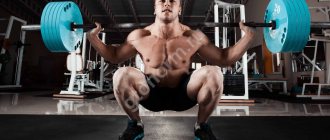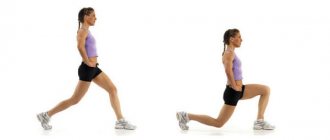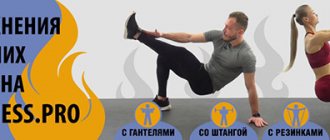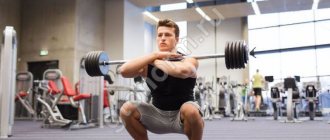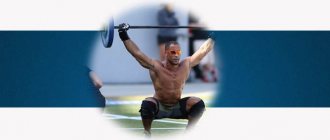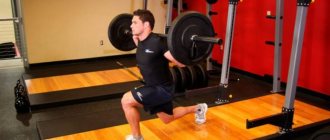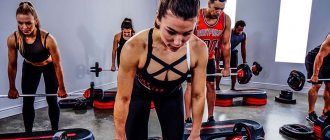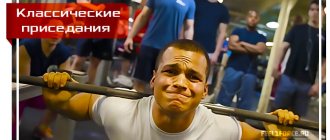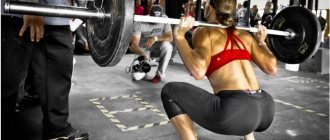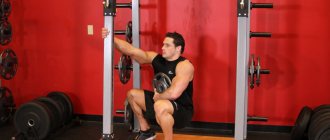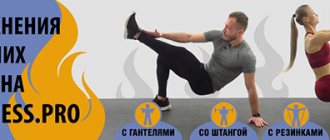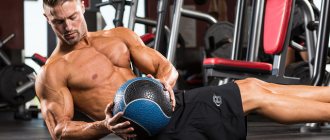The habit of leading a healthy lifestyle is addictive, so fitness is increasingly gaining popularity. A favorite exercise both in the gym and among home workouts among weightlifters and fitness athletes is the squat. It can not only burn calories and help reduce fat, but also round the buttocks, give them a beautiful shape, tighten the hips and make the legs sculpted.
What are the varieties?
Once the classic technique has been mastered, you can move on to more complicated options. At its core, the execution technique is practically no different. The exception is the presence of burdens
What is important? Hold it correctly and find balance. Let's take a closer look
Jumping out of a deep squat
You can increase the amplitude by doing a low squat. Jumping from a deep squat is no different in technique.
The amplitude can be expanded by decreasing the depth. And to do this, at the moment of lowering, it is enough to reach the calves with the biceps of the thigh. This will be the deepest position from which you need to jump. For the first time, we recommend trying to do it without weights.
Jumping out of a squat with a barbell, dumbbells or kettlebell
In the exercise, it is important to use each of the weights available in the gym.
What changes when using different weights? Essentially, a vector of load on muscle groups. As for the execution technique, it is absolutely identical.
The main difference when using weights is its correct location. It should not interfere with training or impair balance and coordination:
- When working with a barbell, it is best to place it on the trapezius muscles. Having taken it with your hands in a tight grip, it should not change its position.
- When working with dumbbells or kettlebells, you need to wrap your hands tightly around them and hold them straight down. Swinging in different directions should not be allowed. The use of wrist straps is allowed.
Contraindications
You cannot do jump squats in the following cases:
- for leg injuries, especially knee joints;
- for hypertension and tachycardia;
- pathological changes in the spine, such as hernia or protrusion.
When performing squat jumps, it is important to remember that the higher you jump up, the greater the effect of the exercise. Don’t forget about the correct technique and contraindications, and your workouts won’t end with injuries, but will help you work out your muscular frame, pump up your buttocks and thighs, and develop endurance.
In terms of effectiveness, such jumps can be compared with front squats with a barbell, and in some ways even better. The jumping squat exercise can be done both at home and in the gym. The effect of the exercise is impressive, so jump squats are gaining more and more popularity not only among professional athletes, but among those who simply want to lose weight and get a sculpted and beautiful body.
What can be replaced
There are many options for replacing this load. The main thing is to take into account which muscles work and find an analogue. Among such exercises, several of the most effective can be identified:
Long squat jumps also work the quadriceps, this is one of the variations of this exercise, but slightly different in execution technique.
Obstacle jumping involves overcoming obstacles by jumping over them.
Lifting the buttocks with a barbell is classified as strength training and works with the same muscle groups.
Jumping rope is an accessible exercise for everyone; in addition to working the legs, it develops endurance; it is more related to the cardio group.
Single-leg squats are a fairly challenging exercise that help improve coordination.
Lunges – based on transferring weight from one leg to the other, do it with weights for noticeable results.
Harm of squats and contraindications
Despite all the beneficial properties, even such a simple exercise can cause serious harm to the body.
The greatest danger is squats with weights: they put a serious load on the knee joints, which are not always able to withstand it. This often applies to people who prefer strength sports. In order not to cause harm to the tendons and joints of the knee area, it is necessary to warm up the muscles before training, which will significantly reduce the risk of injury. Squats are strictly contraindicated for people with knee joint diseases, since exercise can only increase inflammation and provoke immediate destruction of the joint. It is not allowed to squat if you have problems with the spine, scoliosis or diseases of the cardiovascular system. In this case, consultation with a doctor is required. Another possible harm factor is being overweight, which puts additional pressure on the knee joints.
That is why overweight people need to do the exercise especially carefully and prudently. Start with a small number of repetitions to monitor the body's reaction
It is also recommended to use special bandages for knee joints.
Types of squats
It turns out that squats can be varied and thereby pump up almost the entire body. You can use weights or fitness bands to increase the load. Experienced trainers identify several types of squats that can improve your figure.
Gun. Its essence is as follows: you need to stand straight, lean on one leg, straighten the other leg parallel to the floor, stretch your arms forward, palms down. After this, you need to do a squat so that ideally your hips touch your heels. When performing the exercise at the bottom point, the second leg should not touch the floor. You also need to get up slowly to avoid injury.
When performing the exercise, it is important to maintain balance and not lower the extended leg to the floor.
One leg squat. Similar to the previous example, only the second leg does not need to be extended forward. It is enough to bend it at the knee and move it forward or backward. When performing the exercise, you need to go as low as possible and return to the starting position. At first, you can lean on a chair or a wall.
Sumo. The starting position of this exercise: legs wide apart and toes turned outward. You need to lower yourself until you get a right angle at the knee joint. To complicate the exercise and increase the load, the trainer may recommend performing a sumo squat on the toes without supporting the heel. So the load on the gluteal and thigh muscles increases many times over.
Pulse Squat. Looks like a standard exercise. The difference is that at the lowest point it is necessary to perform three springing movements of the pelvis (amplitude 4-5 cm). Surfer. The starting position is as follows: a squat is performed with legs wide apart, arms spread to the sides. The stance should resemble a surfer on a board. When jumping, you should turn around so as to land on an imaginary attribute on the other side. Cross leg squat
It is important to stand up straight, place your feet shoulder-width apart, and place your hands on your hips. It is important to remember that both knees resemble a right angle when performing the exercise.
One leg is brought back and to the left, a squat is performed. Squat on a chair. The athlete stands straight and places his feet together. You need to perform a squat with your pelvis pulled back until your thighs are parallel to the floor. An outside view: a man sits down on a chair. Grand plié. You need to stand up straight, place your heels together and toes apart. When performing the exercise, you cannot move your hips back, but you need to sit down straight down. If it is very difficult to perform such a stance, you can lift your heels off the floor at the lowest point. You need to return to the starting position slowly. Buttocks to heels. The athlete joins his legs together and extends his arms forward, palms down. He needs to squat down so that his buttocks touch his heels. To maintain balance at the lowest point, you can rest your hands on the floor. Squat twist. Feet are placed shoulder-width apart and a standard squat is performed. When returning to the starting position, you need to touch the opposite elbow with your knee and twist your body. Jump squats. This particular exercise can have several variations.
Squats are a great way to keep your lower body toned.
This natural exercise for the body does not require additional equipment and at the same time involves many muscle groups at once. But doing 100 classic squats is quite boring and few people can do it. Another thing - 10 by 10!
This set of exercises will take less than 10 minutes, and the results will be noticeable within 1-2 weeks.
Safety precautions
Before performing the complex, be sure to warm up: it will help make the muscles more flexible and the workout more effective. Plus it will reduce the likelihood of joint damage. To better work the gluteal muscles, squats should be performed as deeply as possible. To avoid damaging your knee joints, do not make sudden movements.
General recommendations for implementation The workout works the lower body: legs and buttocks. But pay close attention to the top one too: tense your stomach; straighten your back; look straight ahead. Perform each exercise 10 times with minimal rest breaks. No additional equipment needed.
1. Regular squats
Regular squats improve the condition of all leg muscles. Go as low as you can. But make sure your back remains absolutely straight. The angle of the back should be approximately the same as that of the shins. Distribute your weight evenly between your heels and toes.
2. Plie
Plie helps make your legs slimmer and your buttocks more rounded. Turn your toes to the side. Ideally, you want to form one line of feet, but the angle of the turn depends on your flexibility and coordination of movements. Smoothly lower yourself as deeply as possible, feeling the tension in your inner thigh. Don't put your head down and don't look at your feet.
3. Squats and side leg raises
4. Pelvic rotation
Rotation of the pelvis allows you to work deeper on the inner thigh. Drop down to your right foot and lift up through your left. Change direction. Lower yourself as deeply as you would in a regular squat and keep your back straight.
5. Squats and leg raises
Raising the leg from a standing position allows you to additionally work the back of the thigh, buttocks and abdominal muscles. Remember to keep your back straight while squatting. Don't lean forward when you move your leg back. Do 10 repetitions, alternating legs.
6. Deep Squat with Triple Spring
A regular squat, complicated by swinging at the bottom point. Squatting deeply down, move your pelvis up and down with an amplitude of no more than 10 cm. Then smoothly return to the starting position. Despite the tension in your legs, try to avoid jerking while lifting.
7. Sumo kick
A deep squat, and then lifting and turning the leg in a circle, puts additional stress on the muscles of the buttocks, as well as the inner and back surface of the thigh. Raise your leg approximately 45 degrees. Try not to bend your leg when lifting, or your back during a deep squat.
8. Side Squats
From the starting position (standing), take a step to the side and lower yourself as deep as possible. Try to place your feet as wide as possible. This will allow you to maximally work the inner thigh and lower buttock muscles.
9. Skier's squats
The springing movement in the lower position works the back of the thigh deeper. Squatting deeply, do two swings of the pelvis with a small amplitude and return to the starting position. “Pick up” imaginary ski poles in your hands, but do not jerk.
10. Jump Squats
Final plyometric exercise: deep squat with jump. Plyometric exercises help to form a harmonious figure and avoid overdeveloped buttocks. Jumping as high as possible, do the exercise at the highest possible pace. But at the same time, make sure that the squats are deep.
Jump squats: technique and implementation features
Classic squats are mainly used to strengthen the muscles of the buttocks and legs. If you complement the squat with a jump, this will make the exercise explosive and aerobic. Jump squats are very commonly used in interval training because they strengthen muscles and increase your heart rate to burn calories. By regularly performing jump squats, you can get rid of excess fat and tone your body, especially your lower part.
Jump squat technique
1. Stand straight with your feet wider than shoulder-width apart. Bend your knees and lower yourself into a squat position. Bring your arms together in front of you or stretch them along your body. The thighs should be almost parallel to the floor, with a right angle between the shin and thigh. The heel is completely on the floor.
2. Jump sharply vertically up, arms down along the body. Don't lower your head, stretch your head up.
3. Return to a squat position. Continue to move dynamically, increasing or decreasing the speed of the exercise as necessary.
What to pay attention to when performing jump squats:
- Keep your back straight during all phases of the movement, while your body is slightly tilted forward
- Lower your shoulders, relax your neck, look forward, bring your shoulder blades together slightly
- Land softly with a springy motion
- When performing squats, do not arch your back in the lumbar region, twist your pelvis back
- Make sure your knees don't go ahead of your toes
If you're doing jump squats to burn calories, strengthen your heart, and develop explosive muscle power, pay attention to the speed of the exercise. The higher the speed, the faster you will raise your heart rate and speed up fat burning
If you are doing jump squats to strengthen and tone the muscles of your lower body, you can additionally use dumbbells, resistance bands, or leg weights. Always perform jumping exercises in running shoes.
Main mistakes when performing jump squats:
- Slouched back, strong body tilt forward
- Knees go forward of the toes
- When squatting, the heel comes off the floor
- Jumping hard and shocking
The picture below shows the main mistakes when performing jump squats. Remember that performing the exercise incorrectly will not only reduce its effectiveness, but can also cause injury to your knees or spine.
How to do jump squats:
- For beginners: 10-12 reps in 3 sets (1 minute rest between sets)
- For intermediate level: 20-25 repetitions in 4 sets (rest 30 seconds between sets)
- For advanced level: 30-35 repetitions in 6 sets (rest 30 seconds between sets)
How else can you do jump squats:
You can perform jump squats using the Tabata principle. What does it mean? Turn on the timer and perform the exercise for 20 seconds in 8 approaches, resting 10 seconds between sets. In total, you will get a very intense 4-minute set to burn calories and strengthen the muscles of the buttocks and legs. This short, explosive workout is called Tabata and is considered one of the most effective ways to improve your body and speed up your metabolism.
All about TABATA training: what it is + exercises
VIDEO of how you can do jump squats:
Examples of workouts
Cardio training is a great way to burn subcutaneous fat, especially when combined with a low-calorie diet.
Such training includes running, swimming, cycling, and training on special cardio equipment. In the process of such exercises, not only active weight loss occurs, but also the cardiovascular system is trained, and the overall endurance of the body increases.
Is it possible to conduct a full-fledged cardio workout at home without having equipment or exercise equipment? Yes, it is quite! We offer an excellent set of five exercises that can be performed in any conditions. All that is required is your desire.
The proposed high-intensity training is circuit training. This means that all five exercises must be performed in the order in which they are given. Having completed one circle, you can rest for no more than 5 minutes and start the exercises again starting from the first. You must complete at least 4 laps.
Attention! You cannot rest between exercises until you complete the circuit!
They are also called "explosive". Starting position is the same as for regular push-ups: lying down. The difference is that at the moment of push-ups it is necessary to push the body upward with force, the arms must straighten and come off the floor. Then you need to land softly. You can complicate the exercise: at the moment you lift your hands off the floor, clap. We perform push-ups 15 times.
This exercise is much more difficult. Starting position - on all fours, knees resting on the chest. With a sharp push we throw our legs back and go into a lying position.
From this position we return to all fours again. Then we jump up, stretching out our whole body, with our hands above our heads making a clap. We return to all fours.
All this must be done continuously, without stopping. Repeat burpees 20 times.
Rock climber
An excellent exercise for the abs, especially the side ones. Stand up straight with your arms outstretched. With a quick movement, pull your left knee towards your chest and bring your leg back. Then we do the same with the right leg. We alternately pull our knees to our chest as quickly as possible, as if we were running up a hill. Must be performed 30 times (15 on each leg).
Starting position – standing, hands behind your head. We squat and then sharply jump up, hands remaining behind our heads. We jump out in this way 15 times.
It is worth noting that the squatting technique in the exercise must be correct. Your knees should not go beyond your toes, as if you were sitting on an imaginary chair.
This technique puts maximum stress on the muscles of the buttocks and back of the thigh.
Sumo squats
Starting position – standing, arms along the body. We squat with our legs spread apart, while our hands are placed point-blank between our legs. This is similar to the pose of sumo wrestlers, hence the name. From this position, we push our legs back so that we are in support while lying on outstretched arms. Return to the sumo squat and return to the starting position. We perform 15 repetitions.
Performing one round of exercises will take no more than 10 minutes. As the body gets used to the load, the speed needs to be increased. You need to train at least three times a week. The table below shows a list of exercises and the number of repetitions for each.
| Exercise | Number of repetitions |
| Plyometric push-ups | 15 |
| Burpee | 20 |
| Rock climber | 30 |
| Squat Jumps | 15 |
| Sumo squats | 15 |
These exercises are included in the complex of the popular CrossFit trend. What makes it special? CrossFit offers high-intensity workouts for all fitness levels that work every muscle in the body and build endurance. The main condition is that you need to perform the exercises quickly and without rest. It is due to this that high training efficiency is achieved.
The proposed exercises put a lot of stress on the joints. It's better if you wear knee pads. There are a lot of jumps in the complex, so you need to choose the right shoes. It must have a shock absorption effect. When jumping barefoot or wearing shoes with thin soles, there is a risk of damaging your knees and feet.
By performing this complex every day, the first results will be visible within a month. The body will become drier and more prominent due to a decrease in the percentage of adipose tissue. If you supplement exercise with a diet high in protein and limited in fat, the fat will gradually be squeezed out by the muscles. You will get a beautiful body without wasting time and money on the gym!
For beginners, you can suggest the following training scheme using the burpee exercise:
- Do the exercise for two minutes.
- Two minutes rest.
- Repeat 3 times or as many times as you can.
You can progress by increasing the number of repetitions of the exercise in the interval, reducing the rest time or adding “circles”.
For intermediate level of training:
- Two minute exercise.
- Rest for one and a half minutes.
- Repeat 5 times.
For advanced athletes:
- Three minute exercise.
- One minute rest.
- Repeat 6 times.
There is also such a technique as the Tabata protocol. In this case, the exercise is performed intensively for 20 seconds, then there is a 10 second break. This is repeated 8 times (4 minutes), then there is a minute rest, etc.
Whichever option you choose, adding burpees to your training program is guaranteed to speed up your metabolism, significantly increase your endurance and explosiveness, and tone your entire body. Show yourself what you are capable of. Good luck!
How to choose the right tires?
We have already said that an accessory can have different degrees of rigidity, according to which the level of complexity increases. According to an unspoken rule, all manufacturers divide the resistance levels of rubber bands by color, and each has its own scale. However, the most common options are:
- Yellow color is the weakest resistance;
- Red color – 2nd load stage;
- Green color – high level of difficulty;
- Blue color – even higher resistance;
- Black color is the hardest elastic band, suitable only for experienced athletes with good physical training.
To make squats with a rubber band not only effective, but also enjoyable, you need to choose the right accessory:
- Expanders are made of latex or cotton. The first ones are cheaper, but they slip, curl up when stretched, cut into the skin and move out. The latter are more comfortable, but their price tag is twice as high as latex ones.
- There are short and long ones. In general, length does not affect the quality of the exercise, but longer loops provide more variation for the exercises.
- There are wide and narrow accessories. When choosing, follow the rule: the wider the tape, the greater the load.
- If you are afraid that during work the elastic band will suddenly break, whipping you painfully during recoil, buy an expander in a sleeve. This is something like a case that will hold the accessory inside, saving you from the discomfort in case of rupture.
- By the way, the stiffer your elastic band is, the more difficult it will be to tear it.
Advantages and disadvantages
What are the benefits of squats for the buttocks with bands on the legs, let's find out!
- It allows you to comprehensively distribute the load, turning it from point to uniform.
- This is an excellent alternative to weights, which are often prohibited for medical reasons. Even athletes with a sore spine can use an elastic band;
- Expanders place virtually no load on the joints;
- Squats with a rubber band are difficult to perform incorrectly - your body, in order to make the task easier for itself, intuitively performs the exercise technically correctly;
- Due to different levels of rigidity, you can easily change the load, which is very convenient;
- The accessory can be used at home, in the gym, and on the street. It folds compactly and fits in any, even very small bag.
- It allows you to burn 200-300 additional kcal to the usual amount when doing squats without a band.
- Such training will make the skin more elastic and eliminate sagging and cellulite.
Of course, there are also disadvantages. First of all, this is the load limit. You can increase the weight on the bar as much as you like, but you won’t put 15 elastic bands on yourself, no matter how much you want to. Secondly, expanders will not help to significantly build muscle, only to form a relief. In order to grow muscles, strength training with weights is necessary. Accordingly, this accessory is not suitable for men seeking to improve their figure, but is ideal for women training to lose weight.
Is there any harm?
Squats are not limited to benefits. There is also a “fly in the ointment” that every athlete should be aware of before building a training program. Many doctors agree that exercise has a negative impact on the health of the knee joints. In addition, such activities stretch the tendons in the knee area, which weakens them and can lead to severe pain.
But this opinion is ambiguous. Other studies conducted in the late 20th century confirmed the absurdity of these claims. At the same time, leg exercises were completely rehabilitated in the eyes of society. The only danger that remains for athletes is the risk of injury when doing weighted squats incorrectly. The movement must be performed with a perfectly straight back. If you have doubts about the correctness of the technique, it is worth engaging a professional who will check the correctness of the exercise and “fix” the technique.
Benefits of Exercise
Improves technique
One of the best things about box squats is that the lifter always has to lower the pelvis below the knees (over parallel) in order to reach the box during the eccentric phase of the exercise. When an athlete performs simple squats, there is a tendency to squat less deeply depending on the weight (the higher the weight, the shallower the squat).
Box squats allow you to completely overcome this problem and after consistent practice with box squats, the athlete will always drop below knee level. Moreover, box squats allow you to improve your technique in the sense that the athlete will always perform a full squat when lowering, and will not just fall down and spring back up. However, springing can also be an advantage, as I will discuss below.
Improves stretching and range of motion
Box squats can be classified as ballistic stretching exercises. This exercise can be very helpful for people with poor stretching and range of motion and makes it easy to measure your progress in this area.
If an athlete cannot lower the pelvis below knee level when performing squats, then simply place the box so that its height is greater. If this is not enough, then you can put a 20 kg barbell plate on it (if necessary, several). As the athlete develops his flexibility in the squat, you can gradually remove the weights and then lower the height of the box until it is below parallel (the height at which you have to lower your pelvis below your knees to sit on the box).
Helps develop strength and power
As I noted, box squats force the athlete to squat backwards rather than simply downwards. This allows the lifter to sit further on the box and achieve a perpendicular (or further greater) angle between the shin and the floor. As a result, he receives a huge load on the gluteal muscles and lower back muscles.
Moreover, since the box squat forces the athlete to overcome the eccentric-concentric relationship, the result is that he develops enormous strength by learning to overcome the concentric phase of the exercise. In addition, at the same time, muscles are used at full strength, which a few seconds before were completely relaxed due to the fact that the athlete was sitting on a box, and not hanging in the air, as with conventional squats.
Yes, springing a standard squat can be helpful and allows you to lift from the bottom of a squat, but if you can lift a ton from a box sit position, there's no doubt you can lift the same weight (or more) with simple squats . In fact, box squats require an athlete to generate three to four times more force than any other type of squat!
Safer
When you're doing standard squats and you lose your balance, the thought arises of twisting your elbows out from under the bar and letting it fall behind you. Of course, not every athlete can correctly cope with the problems that may arise during the performance of squats (loss of balance, too much weight, etc.), and if your legs begin to shake when you are at the bottom of the squat, get out of this the situation will be difficult, even if you are an experienced athlete.
If the weight turns out to be too heavy when performing a box squat, then you have insurance in the form of this very box behind you. If you can’t get up, just call your spotters and they will help you get up. Fortunately, this won't be a big problem because when you do box squats, you use less weight and have to do everything in a better stance, which allows you to reduce the pressure on your back. Finally, the perpendicular angle between the shin and the floor reduces the stress on the kneecap, making this type of squat much more gentle on the knees.
Burpee
So, the essence of the exercise is clear. Now let's figure out why it is needed, what benefits it provides, and what physical qualities it develops. In other words, why it makes sense to master burpees even if you're not particularly interested in CrossFit.
The first indisputable advantage is that the exercise involves working a large number of muscle groups throughout the body. After all, you consistently perform push-ups and jumping jacks from a deep squat, interspersing all this with a plank pose on straight arms.
The following muscle groups receive the greatest load:
- Quadriceps, hamstrings, glutes, calves.
- Large pecs, triceps.
- Deltoid muscles.
- Press.
Almost every muscle in your body is recruited to perform this complex, coordinated movement. Combined with the speed of execution, this results in enormous energy consumption.
Burpees have a number of other benefits:
- In order to push yourself to the fullest, you do not need any additional equipment. Just your own body and a couple of square meters on the floor. This makes the exercise universal. You can train in the gym, at home, on the street, in a hotel room on vacation, basically anywhere.
- Exercise trains the respiratory and cardiovascular systems, circulates blood throughout the body and accelerates metabolic processes in the body. By spending a few minutes exercising in the morning, you will be alert and energetic all day long.
- The exercise develops explosive strength, speed, coordination and balance. You learn to control every muscle of your body, perform movements quickly, clearly and consistently.
- The high calorie consumption during exercise makes it an ideal tool in the fight against excess fat. Do you want to lose weight, get lean, burn off the piece of cake you ate? Get started!
- Saving time, which is important for many busy people. Give yourself a few short intervals of work and rest every day, and you will get excellent physical exercise. To maintain health and well-being, this alone will be enough.
Contraindications to performing the exercise are any injuries, painful conditions, problems with blood pressure, heart or blood vessels. To begin an intense workout, you must feel good.
So, let's move on to execution techniques and variations.
This exercise can only evoke two feelings: either you love it or you hate it! What you love about burpees is that they really give results, don’t require any additional equipment, and can be done anywhere! And hate it because it is simply deadly heavy!
Burpees combine a squat, push-up, and jump into sequential movements that are performed at a fast pace. This exercise is included in training programs for people who are required to have high physical performance: firefighters, special forces, professional athletes of individual and team sports. This is because burpees involve almost all the muscles in our body!
Burpee is a multi-joint exercise that involves several muscle groups at once. The most loaded muscles are the legs (hamstrings, glutes and calves), and the load also falls on the pectoral muscles, triceps and shoulders. The abdominal muscles are involved. There are practically no muscles that burpees do not affect.
- Do a squat, placing your palms in front of you.
- Kick your legs back into a prone position.
- Do some push-ups.
- Immediately after the push-up, tuck your legs under you, returning to the squat position.
- Jump up from a sitting position, straightening your entire body and clap your palms above your head.
This is one "burpee" or "burpee". The exercise is performed at the fastest possible pace, with maximum intensity and the inclusion of all possible muscles.
- strengthening the muscles of the whole body;
- development of core muscle strength - 29 muscle pairs located in the pelvis, abdomen and lower back form the core necessary to maintain the balance of the human body; (Read more in the article)
- burning a lot of calories during the exercise (this factor depends on the number of repetitions, speed of execution and your current weight)
- acceleration of metabolism for the whole day, that is, the benefits of the exercise remain even after you finish the workout;
- development of flexibility;
- development of coordination/balance and endurance;
- “pumping” of the cardiovascular system, improving the functioning of the heart and lungs;
There are different options for adapting the exercise. It can be made easier and more difficult. Beginners can skip the push-up and remain in the plank position, or skip the jump. You can increase the intensity of burpees by adding a forward or side jump between repetitions. Some people use weights and dumbbells and even do pull-ups between reps!
burpee technique
To incorporate burpees into your workout, try doing a few sets at a free pace. After the first couple of sets, be prepared to increase your speed of movement. For optimal results, try to do it at the maximum pace. Ideally, you will do 100 burpees. The result will be visible within a week.
Here are some ways to use burpees in your workout: Do 100 reps as quickly as possible, or see how many reps you can do in 10 minutes. You can also try doing the so-called 20 to 1 pyramid: do 20 burpees, rest for a couple of seconds, do 19 reps and rest again.
If you're just starting out, alternate burpees with other exercises.
Even a few sets of 10 burpees per set will get your heart racing and your breathing noticeably faster, your legs will feel like they are filled with lead, your arms will shake and you will feel that your muscles have become stronger. Do them regularly and you will see your fitness improve rapidly.
Again, this is a full-body exercise, which means you'll be using every muscle in your body, meaning you'll burn more calories in less time.
It is estimated that on average, a man weighing 82 kg burns 1.43 calories per burpee. If you do at least 7 per minute, then the figure doubles. But you need to aim for 10 burpees per minute, i.e. to the figure of 14.3 calories per minute. Why? 10 reps at high speed can fire up your metabolism just as much as a full 30-second sprint on the bike, making burpees a killer cardio exercise.
Correct technique for performing the exercise
Below we will look at the most correct technique for performing jump squats, by studying which you can significantly increase the amount of work performed in training.
Starting position
- We place our feet shoulder-width apart;
- The feet are placed slightly apart;
- The back is straight;
- We cross our arms on our chest;
- The gaze is directed forward.
If you are performing an exercise with a barbell, place it on the trapezius muscles and squeeze it tightly with your palms; it should not change its position throughout the approach.
If you are performing the exercise with dumbbells, grab them tightly with your hands (you can use wrist straps or hooks) and try to keep them pointed straight down throughout the entire approach. If the dumbbells swing from side to side, you risk shoulder injury.
Squat
Perform a deep squat, keeping your back straight and not rounding your sacrum. Try to touch your thigh biceps to your calf muscles - this will be our lowest point of amplitude. Do not change the position of the apparatus if you perform the exercise with additional weights.
Jerk
Begin an explosive upward movement, trying to straighten your legs as quickly as possible, and exhale sharply as you do so. After this, try to lift your feet off the ground; due to the given powerful acceleration, you will lift off the ground by several tens of centimeters. Watch the position of the barbell and dumbbells during the jump. If you are outweighed and cannot control the movement, reduce the working weight or perform jumping exercises with your own weight.
"Landing"
When you have already started to go down, inhale and concentrate on landing with your legs slightly bent and immediately continue moving down - this way you will minimize the risk of injuring your knee joints. Land, immediately lower yourself as low as you can and perform one more repetition without pausing after landing or at the bottom. The work must be continuous so that the thigh muscles are in constant tension.
Jumping from a prone position how to do it, video of performing technique
This jump squat variation is for people who like a more challenging workout. Stand in front of a large, stable obstacle. Can be used . Do a regular squat, push hard off the floor and jump with both feet onto the obstacle. At the top, do a squat again and jump back. Land very softly! Start with small steps, then you can increase the height.
Then, when you master the movement well, you can increase the height. Be very careful, this is a difficult exercise. It is not worth practicing without good preparation, as it is very easy to get injured.
6 minutes for reading 345 views
600 exercises, 100 training programs for Mass Gain, Strength, Lean Body. Routines for Home and Gym. This is a fitness revolution!
Jumping from a prone position is a complex complex fitness exercise, which, in addition to pumping up the abdominal press, is suitable for losing weight in the abdomen and sides. It is an extremely effective exercise for training the heart muscle, pumping up the lower and middle abs and burning calories. Can be used to work on relief in the lower abdominal area.
- Take a lying position, pull your stomach in, tension in your lower back, neck straight.
- Bend your straight arms slightly at the elbows and place them shoulder-width apart.
- Exhale as you jump, bend your knees and bring them as close to your chest as possible.
- Inhale and jump your legs back to the starting position.
If the correct technique is followed, the following muscle groups work: Triceps, Chest, and auxiliary muscles: Abs
You can try replacing the exercise “Prone Jumping Jumps” with one of these exercises. The possibility of replacement is determined on the basis of the muscle groups involved.
Jump Squats
Squat jumps are the “plyometric” version of classic squats. The exercise belongs to the category of functional exercises, combining strength and cardio exercises.
The movement maximally involves the muscles of the thigh, gluteal muscles, adductor muscles (with wide stance of the legs), as well as the muscles of the lower leg and core.
Preparation for execution
Before plyometric squats, you should first of all stretch your knee joints and ankles well, and also warm up your thigh muscles. To do this, in addition to the classic warm-up and joint gymnastics, you can perform any running exercises.
Execution technique
Initial position:
- Take a starting position standing with your feet shoulder-width apart.
- Turn your toes slightly outward.
- Straighten your back and extend your arms to the sides of your body.
Movement:
- As you inhale, lower yourself into a deep squat (at least until your thighs are parallel to the floor), while simultaneously stretching your arms in front of you and pushing your pelvis back.
- Hold for a second in the bottom position.
- As you exhale, use an explosive force from your hips to jump up as high as possible, bringing both arms back behind your hips. Stretch your body straight as you jump.
- Land softly on your toes and without pausing, begin to squat again.
- Perform the movement in the volume provided for in the training plan.
Attention!
- Don't bring your knees inward as you land. This may cause injury to the knee joints.
- Don't lean forward too much. This may cause you to lose your balance and fall.
- Don't land on straight legs. In this case, the entire shock load falls on the knee joints.
- Don't slouch to avoid injuring your back. This rule should be strictly followed, especially when working with weights.
- Keep your heels off the floor while squatting. In this case, the ligaments of the knee joint experience additional stress.
Recommendations!
- Before you start jumping squats, perfect your classic squat technique. Since the exercise is explosive in nature, the risk of injury is increased.
- Land with your knees slightly bent. This will partially “extinguish” the impulse acting on the joints. For this purpose, it is also recommended to perform squats in shoes with shock-absorbing soles that absorb shock.
- When jumping out of a squat, help yourself with your hands. By swinging your arms strongly during the push, you create additional inertia, which allows you to jump higher.
- To make the exercise more difficult, you can further group yourself and pull your knees toward your chest while “flying.”
- Use additional weight if you have exceeded the basic load level. The weight can be a disc, kettlebell, dumbbells or barbell.
Execution options!
Explosive squats with wide stance. The exercise involves all the same muscle groups as in the classic position of the legs, but the adductor muscles of the thigh receive additional noticeable load. This version of the exercise appears more often in women's complexes.
We use weights
Some athletes use additional weight (for example, dumbbells) or a complication in the form of jumping onto an elevated surface. But this option increases the risk of joint injuries; if you land poorly, you can damage your ankle and sprain ligaments.
If you plan to do weighted jump squats, we recommend using comfortable dumbbells for this purpose. In this case, the technique is adjusted:
- It is better to hold dumbbells in straight arms pointing downwards. The squat is also done while inhaling, the back is straight.
- Push off the floor and jump as high as possible. The arms are still straight and pointing down.
- Soft landing with a squat.
